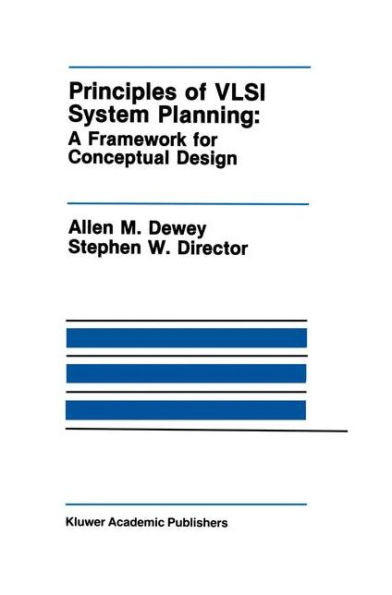Principles of VLSI System Planning: A Framework for Conceptual Design
This book describes a new type of computer aided VLSI design tool, called a VLSI System Planning, that is meant to aid designers dur ing the early, or conceptual, state of design. During this stage of design, the objective is to define a general design plan, or approach, that is likely to result in an efficient implementation satisfying the initial specifications, or to determine that the initial specifications are not realizable. A design plan is a collection of high level design decisions. As an example, the conceptual design of digital filters involves choosing the type of algorithm to implement (e. g. , finite impulse response or infinite impulse response), the type of polyno mial approximation (e. g. , Equiripple or Chebyshev), the fabrication technology (e. g. , CMOS or BiCMOS), and so on. Once a particu lar design plan is chosen, the detailed design phase can begin. It is during this phase that various synthesis, simulation, layout, and test activities occur to refine the conceptual design, gradually filling more detail until the design is finally realized. The principal advantage of VLSI System Planning is that the increasingly expensive resources of the detailed design process are more efficiently managed. Costly redesigns are minimized because the detailed design process is guided by a more credible, consistent, and correct design plan.
1102341629
Principles of VLSI System Planning: A Framework for Conceptual Design
This book describes a new type of computer aided VLSI design tool, called a VLSI System Planning, that is meant to aid designers dur ing the early, or conceptual, state of design. During this stage of design, the objective is to define a general design plan, or approach, that is likely to result in an efficient implementation satisfying the initial specifications, or to determine that the initial specifications are not realizable. A design plan is a collection of high level design decisions. As an example, the conceptual design of digital filters involves choosing the type of algorithm to implement (e. g. , finite impulse response or infinite impulse response), the type of polyno mial approximation (e. g. , Equiripple or Chebyshev), the fabrication technology (e. g. , CMOS or BiCMOS), and so on. Once a particu lar design plan is chosen, the detailed design phase can begin. It is during this phase that various synthesis, simulation, layout, and test activities occur to refine the conceptual design, gradually filling more detail until the design is finally realized. The principal advantage of VLSI System Planning is that the increasingly expensive resources of the detailed design process are more efficiently managed. Costly redesigns are minimized because the detailed design process is guided by a more credible, consistent, and correct design plan.
169.99
In Stock
5
1

Principles of VLSI System Planning: A Framework for Conceptual Design
202
Principles of VLSI System Planning: A Framework for Conceptual Design
202Hardcover(1990)
$169.99
169.99
In Stock

Product Details
| ISBN-13: | 9780792391029 |
|---|---|
| Publisher: | Springer US |
| Publication date: | 05/31/1990 |
| Series: | The Springer International Series in Engineering and Computer Science , #97 |
| Edition description: | 1990 |
| Pages: | 202 |
| Product dimensions: | 6.10(w) x 9.25(h) x 0.24(d) |
From the B&N Reads Blog
